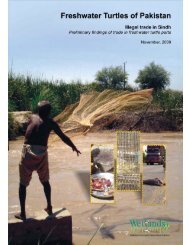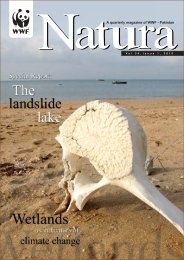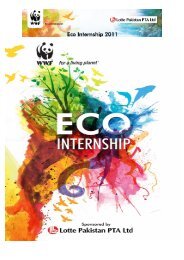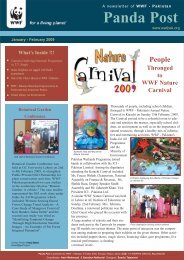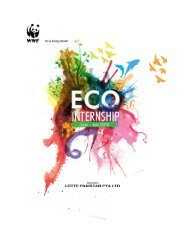Freshwater Turtles of Pakistan
Freshwater Turtles of Pakistan2-2007 - WWF-Pakistan
Freshwater Turtles of Pakistan2-2007 - WWF-Pakistan
Create successful ePaper yourself
Turn your PDF publications into a flip-book with our unique Google optimized e-Paper software.
1. Introduction<br />
There are about 300 species <strong>of</strong> tortoises and freshwater turtles in the world (the exact<br />
number is debated). IUCN’s Red List Authority has so far assessed approximately 200<br />
species and has already found 122 to be threatened 1 . 74 percent <strong>of</strong> the 90 species <strong>of</strong> Asian<br />
freshwater turtles and tortoises are considered as threatened. According to the<br />
IUCN/Species Survival Commission Tortoise and <strong>Freshwater</strong> Turtle Specialist Group and the<br />
Asian Turtle Trade Working Group, consider over half <strong>of</strong> the Asian freshwater turtle and<br />
tortoise species as endangered, including 18 critically endangered species 2 .<br />
1.1 Importance <strong>of</strong> freshwater turtles<br />
<strong>Freshwater</strong> turtles are major biodiversity components <strong>of</strong> the aquatic ecosystem, <strong>of</strong>ten serve<br />
as keystone species benefiting other animals and plants, and represent major resources <strong>of</strong><br />
their environments. They participate in the web <strong>of</strong> interacting and co-dependent species that<br />
constitute a healthy functioning <strong>of</strong> ecosystem. Without turtles, those aquatic ecosystems<br />
would gradually degrade in ways still incompletely understood, and would suffer from the<br />
loss <strong>of</strong> biodiversity 3 .<br />
1.2 Threats to freshwater turtles on global scale<br />
<strong>Turtles</strong> and tortoises have existed for nearly 300 million years, since the Triassic Era, long<br />
before many dinosaurs walked the earth. <strong>Turtles</strong> and tortoises have evolved remarkable<br />
body armour that has remained relatively unchanged through evolution, and while other<br />
vertebrate species have arisen and subsequently gone extinct. The basic body form <strong>of</strong> the<br />
turtle shell has remained an obvious testament to the success <strong>of</strong> turtles and their ability to<br />
survive millions <strong>of</strong> years <strong>of</strong> natural selection pressures. Successful adaptations that helped<br />
turtles survive in the past include, delayed sexual maturity, high juvenile mortality, and a long<br />
adult life-span with low natural mortality. These adaptations however have left turtle<br />
populations vulnerable to new, potentially devastating threats posed by human exploitation<br />
and development related pressures 3 . Following are the major threats to freshwater turtles on<br />
global scale;<br />
1.2.1 Illegal trade <strong>of</strong> freshwater turtles<br />
Two main types <strong>of</strong> turtle trade occur in Asia. One is a high-volume, commodity type trade in<br />
turtles or turtle parts for consumptions; the other is pet trade, which involves smaller number<br />
<strong>of</strong> animals, and <strong>of</strong>ten smaller animals, with high individual value. From a conservation<br />
perspective, the consumption trade can be further divided into the trade in commercially<br />
farmed turtles and the trade in turtles captured from nature. Each <strong>of</strong> these trade segments<br />
gives causes for concern, but the mass exploitation <strong>of</strong> wild-caught turtles for consumption is<br />
the more significant one 4 .<br />
1.2.2 <strong>Freshwater</strong> turtles- a source <strong>of</strong> food<br />
Demand for turtle meat is met from the commercial trade <strong>of</strong> turtles from Vietnam to<br />
Bangladesh to Indonesia-even from parts <strong>of</strong> North America. Shipments <strong>of</strong> thousands <strong>of</strong> live,<br />
adult turtles arrive daily in major Chinese markets 5 .<br />
1.2.3 Parts <strong>of</strong> freshwater turtles used in traditional Chinese medicines<br />
The ecological stress resulting from increased harvesting <strong>of</strong> Traditional Chinese Medicine<br />
products is felt far beyond China’s borders. Many species <strong>of</strong> Asian turtles, used to make a<br />
popular “turtle jelly” are now threatened with extinction 6 .<br />
1.2.4 Habitat destruction<br />
The threats to the tortoises and freshwater turtles are further magnified by changes to their<br />
habitat resulting from human activities. From logging to slash-and-burn agriculture to<br />
<strong>Freshwater</strong> Turtle Survey, 2007 Page 7 <strong>of</strong> 23





